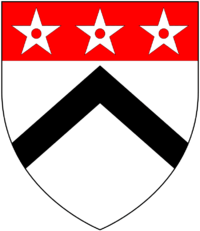Sir Edmund Fowell, 1st Baronet
Sir Edmund Fowell, 1st Baronet (1593 – October 1674) of Fowelscombe in the parish of Ugborough[2] in Devon, was a Member of Parliament for Ashburton in Devon from 1640 to 1648.

Origins
He was the 3rd son and eventual heir of Arthur Fowell (born 1552) of Fowelscombe, by his wife Maria Reynell, a daughter of Richard Reynell (d.1585) of East Ogwell[3] in Devon, Sheriff of Devon in 1585.[4]
Career
He inherited the paternal estates on the death of his elder brother Arthur Fowell (1582-1612), who drowned in an accident at Ford.[5] He was knighted at Greenwich Palace on 3 November 1619. In November 1640 he was elected Member of Parliament for Ashburton in the Long Parliament. He did not sit in the Rump Parliament after 1648. He was a member of the parliamentary committee and was a Deputy Lieutenant of Devon. During the Civil War was president of the Committee for Sequestration. He was created a baronet on 30 April 1661.[3]
Marriage and children
He married Margaret Poulett, a daughter of Sir Anthony Poulett (1562–1600) (alias Pawlett, etc.), of Hinton St George[1][3] in Somerset, Governor of Jersey and Captain of the Guard to Queen Elizabeth I and a sister of John Poulett, 1st Baron Poulett (1585–1649).[6] By his wife he had four sons and six daughters including:
- Sir John Fowell, 2nd Baronet (1623–1677), of Fowelscombe, eldest son and heir.
- Anthony Fowell (1636-1636), second son, died in infancy.[5]
- Edmond Fowell (1637-1632) of Penquit, 3 miles east of Fowelscombe, 3rd son, who married Bridget Browne, a daughter of Thomas Browne of East Allington, but died leaving no sons.[5]
- Thomas Fowell (1638-1639), 4th son, died in infancy.[5]
- Elizabeth Fowell (1622-post 1671), wife of Richard Cabell (d.1677) of Brook Hall,[7] in the parish of Buckfastleigh, Devon, known to posterity as "Dirty Dick", and believed to be the inspiration for the wicked Hugo Baskerville, "the first of his family to be hounded to death when he hunted an innocent maiden over the moor by night",[8] one of the central characters in Conan Doyle's novel The Hound of the Baskervilles (1901-2),[9] the tale of a hellish hound and a cursed country squire. Cabell's tomb survives in the village of Buckfastleigh.[10][11] Conan Doyle's Baskerville Hall is believed to be inspired by one of three Devon mansions: Fowelscombe, Brook Hall and Hayford Hall, also in the parish of Buckfastleigh.[9]
Death
Fowell died in 1674 at the age of 81 and was buried in Ugborough Church.[5]
References
- Vivian, Lt.Col. J.L., (Ed.) The Visitations of the County of Devon: Comprising the Heralds' Visitations of 1531, 1564 & 1620, Exeter, 1895, p.369
- Risdon, Tristram (d.1640), Survey of Devon, 1811 edition, London, 1811, with 1810 Additions, p.179
- John Burke, John Bernard Burke A genealogical and heraldic history of the extinct and dormant baronetcies
- Vivian, p.643, pedigree of Reynell
- Vivian, p.370
- Pole, Sir William (d.1635), Collections Towards a Description of the County of Devon, Sir John-William de la Pole (ed.), London, 1791, p.316
- Vivian, p.125, pedigree of Cabell
- https://www.telegraph.co.uk/travel/723674/Dartmoor-In-the-footprints-of-a-gigantic-hound.html
- Weller, Philip, The Hound Of The Baskervilles - Hunting the Dartmoor Legend, Devon Books, Halsgrove Publishing, c.2002, quoted in
- Spiring, Paul (2007). "Hugo Baskerville & Squire Richard Cabell III". BFROnline. Retrieved 29 March 2009.
- "Cabell Tomb — Buckfastleigh". Devon Guide. 2007. Retrieved 29 March 2009.
| Parliament of England | ||
|---|---|---|
| Preceded by Constituency in abeyance |
Member of Parliament for Ashburton 1640–1648 With: Sir John Northcote, 1st Baronet |
Succeeded by Not represented in Rump Parliament |